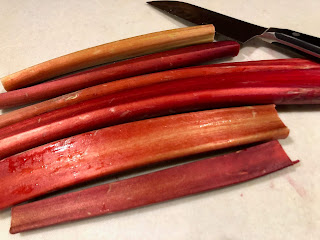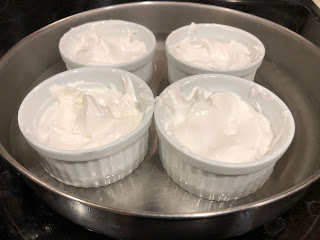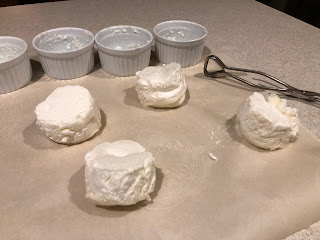
Recipe: Seasonal fruit stars in floating island dessert
 |
| Strawberry-rhubarb compote is topped with a meringue "island." (Photos: Kathy Morrison) |
The appeal of rhubarb was lost on me for decades. When I was a 6-year-old in Tacoma, Wash., my mom baked some of the plentiful local rhubarb in a pie with spring strawberries. The tart-sweet combination offended my undeveloped palate so much -- what a thing to do to strawberries! -- that I didn't touch rhubarb again until the next millennium.
Fast-forward to this past March, at a French restaurant with a regional touch. One of the desserts on the menu was "ile flottante" -- floating island, which I remembered as being custard or creme anglais with an egg-white thing on the top. What arrived was a lovely surprise: a dish of thick pink sauce made from strawberries and kiwis, topped with a gorgeous soft meringue, accented with a shard of toffee. The chef had remade the dessert using the fresh fruit he had available.
Here was a farm-to-fork cook's delight and challenge: Recreate this dessert in a home kitchen. Debbie suggested using a strawberry-rhubarb compote as the base, and I was off on my recipe adventure. I read through a lot of cookbooks and recipes before deciding on the ingredients used here, but I owe a nod to Deborah Madison's "Seasonal Fruit Desserts" for the most inspiration. The ramekin-poaching method for the islands -- a welcome alternative to most recipes' method of spooning the meringues directly into hot water -- was found on a British cooking website, bbcgoodfood.com
The compote, by the way, is lovely on its own or swirled into Greek yogurt. If the island meringue seems too much to bother with, just top the fruit sauce with some crème fraîche or very lightly sweetened whipped cream.
Strawberry-rhubarb floating island
 |
| Rhubarb looks just like red celery, doesn't it? |
Serves 4, with extra compote
Compote ingredients:
6 stalks rhubarb, leaves and ends trimmed
1/2 cup turbinado (raw) sugar
Zest of 1 orange
Juice of 1 orange, plus water to make 1/4 cup liquid
1/4 teaspoon salt
Pinch of ground cloves
2 to 3 tablespoons fruity red wine
2 cups sliced fresh strawberries
Meringue ingredients:
Safflower, canola or other neutral cooking oil
2 egg whites
1/8 teaspoon vanilla extract
Pinch salt
4 tablespoons granulated sugar (use superfine baking sugar if you can find it)
Fresh strawberry slices, for serving
Instructions:
Make the compote: Chop the rhubarb into 1/2-inch pieces, splitting any pieces that are overly wide. Discard any strings that come off. You should have at least 3 cups rhubarb pieces. Place the rhubarb, sugar, zest, juice/water, salt and cloves in a large saucepan. Stir in 1 tablespoon of the wine.
 |
| Compote ingredients are ready to be cooked. |
Bring the mixture to a boil over medium-high heat, then reduce heat and simmer 10 minutes. Stir in the strawberries and 1 more tablespoon wine. Simmer another 10 minutes, then test the rhubarb for doneness. Most of it should have broken down by now, but a few chunks may not have. Also, if the mixture seems too thick, stir in another tablespoon of wine or a bit more water. Adjust any seasoning as necessary.
Simmer 5 more minutes, then remove from heat and let cool. Place in a glass or other non-reactive container, cover and chill until ready to serve. The compote will thicken a bit as it chills.
Make the meringue islands: Use the oil to lightly grease the insides of 4 individual heat-proof ramekins.
Put the egg whites in a mixer bowl with the vanilla extract and salt, and whip just until soft peaks form. Add the sugar and whip until stiff, glossy peaks form.
 |
|
Ramekins are filled and placed in the skillet, then water
is poured in. A lid or foil will keep the heat in and poach-steam
the meringues. |
Spoon the egg white mixture evenly into the prepared ramekins. Have a kettle of boiling water at ready. Set the ramekins in a wide skillet or pot on the stove, and carefully pour the hot water into the pot around the ramekins until it comes up to the middle of the dishes. Cover the pot with a lid or foil, turn the heat on to medium, and simmer 4 to 6 minutes. (You can remove the cover to check after 4 minutes.) The meringues will puff up a bit before settling. They'll hold together but still be soft, not unlike marshmallows.
Carefully remove the ramekins from the pan -- I used tongs. Run a thin knife inside the edge of each, and unmold the meringues onto a piece of parchment paper or wax paper. Set them aside until ready to serve; they will be fine for 3 or 4 hours at room temperature, depending on how warm your kitchen is, or place them carefully in a covered container in the refrigerator for up to 12 hours.
To serve: Spoon or pour compote into each serving bowl, top with a meringue island and sliced strawberries.
Any remaining compote will keep in the refrigerator for a few days.
 |
|
The unmolded meringues made with 3 egg whites were bigger
than I expected.
|
Note on meringues: I initially was afraid mine would be too small, and so had another egg white and 2 more tablespoons of sugar in the mixture. But the resulting islands (see photo) were almost too big for the dessert, so the recipe was adjusted back down. But if you want to make extra large islands -- or more of them, in fact, with more ramekins -- use 3 egg whites, 1/4 teaspoon vanilla and 6 tablespoons granulated sugar, and follow the recipe as above.
Comments
0 comments have been posted.Sacramento Digs Gardening to your inbox.
Sites We Like
Garden Checklist for week of May 12
Get your gardening chores and irrigation done early in the day before temperatures rise.
* Plant, plant, plant! It’s prime planting season in the Sacramento area. Time to set out those tomato transplants along with peppers and eggplants. Pinch off any flowers on new transplants to make them concentrate on establishing roots instead of setting premature fruit.
* Direct-seed melons, cucumbers, summer squash, corn, radishes, pumpkins and annual herbs such as basil.
* Harvest cabbage, lettuce, peas and green onions. This heat will cause leafy greens and onions to flower; pick them before they bolt.
* In the flower garden, direct-seed sunflowers, cosmos, salvia, zinnias, marigolds, celosia and asters.
* Plant dahlia tubers. Other perennials to set out include verbena, coreopsis, coneflower and astilbe.
* Transplant petunias, marigolds and perennial flowers such as astilbe, columbine, coneflowers, coreopsis, dahlias, rudbeckia and verbena.
* Keep an eye out for slugs, snails, earwigs and aphids that want to dine on tender new growth.
* Feed summer bloomers with a balanced fertilizer.
* For continued bloom, cut off spent flowers on roses as well as other flowering plants.
* Got fruit trees? If you haven't already done so, thin orchard fruit such as apples, peaches, pears, pluots and plums before they grow too heavy, breaking branches or even splitting the tree. Leave the largest fruit on the branch, culling the smaller ones, and allow for 5 to 6 inches (or a hand's worth) between each fruit.
* Thin grape bunches, again leaving about 6 inches between them. For the remaining bunches, prune off the "tail" end, about the bottom third of the bunch, so that the plant's energy is concentrated in the fruit closest to the branch.
* As spring-flowering shrubs finish blooming, give them a little pruning to shape them, removing old and dead wood. Lightly trim azaleas, fuchsias and marguerites for bushier plants.
* Add mulch to the garden to help keep that precious water from evaporating. Mulch also cuts down on weeds. But don’t let it mound around the stems or trunks of trees or shrubs. Leave about a 6-inch to 1-foot circle to avoid crown rot or other problems.